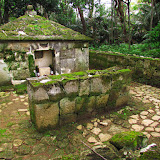 |
| The Tomb of King Gihon |
View Map It! Okinawa in a larger map
 |
| The Tomb of King Gihon |
GPS
| Latitude | Longitude |
| N 26 51.507 | E 128 15.658 |
The Tomb of King Gihon
One of the mysteries surrounding the Old Ryukyu Kingdom is the disappearance of King Gihon, the third and last king of the Shunten Lineage.(1,4) The fallen leader relinquished his throne to King Eiso in the 13th Century due to a set of failures (famine, drought, etc.) that plagued his rule.(1,2,3) It is widely believed that after his abdication he fled north to a place that Okinawans call Asumui located near Cape Hedo of the present day Kunigami Village District. His tomb is believed to be in the town of Hedo(3), some 50 meters away from Highway 58.
On February 20, 2013 the Kunigami Board of Education reopened the tomb to examine the contents inside. It was discovered that at least 5 to 6 sets of human remains were found in a very large burial urn (broken on one side). Because of the urn's size (1 meter in diameter) researchers believe it was placed inside the tomb before it was totally encased. The belief that King Gihon was buried in Hedo seems to date back past the latter part of the 19th Century. It was said that members from the Sho Family (some time during the Meiji Period, 1868-1912) traveled to Hedo to restore the burial site.(1,4) How the news of Gihon's death and whereabouts of his remains got back to Shuri is not clear.
Born in 1206, Gihon became king in 1249. Okinawans would endure widespread tragedy throughout his tenure.(1,2,3) As a result, he initially appointed Eiso as a regent (sessei) to manage his affairs and after 11 years, he finally relinquished all power to Eiso.(1,4) But even during his rule, it would appear that King Gihon desperately tried to improve the situation for his kingdom. It was once said that he offered himself as a human sacrifice in exchange for much needed rain. Legend has it that the gods where apparently pleased and Gihon's life was spared at the last moment as rain finally descended from the heavens dousing the pyre of where he was to be burned alive.(3) King Gihon also had a minor role in the Legend of Yara Muruchi which took place in what is now present day Kadena Town. See article, Legend of Yara Muruchi.
Epilogue. It is not conclusive if the remains in Hedo belong to the King Gihon, or who the other remains belong to. Further analysis is still required. Others claim his final resting place is in Kitanakagusuku Village.(1) The tomb in Hedo does seem fitting for a king however. Though you may not be able to see it when standing in front of the tomb (masked by trees that lay behind it), the mausoleum sits below Mt. Nishime, considered by some as one of the most sacred areas of Okinawa.
Author's Note.
1. Asumui is an Okinawan name you will seldom see in English literature on Okinawa. Some Okinawans rank Asumui (to include Mt. Nishime) up there with Sefa Utaki in terms of its spiritual value . It is not certain what the first half of the word means, but the term mui is of the Okinawan language meaning forest often used as a suffix for the entire name.
2. The belief that King Gihon abdicated his own throne is one theory. Information provided by the Kunigami Village District (sign on site in English) also notes that he might have been forced out of power by an angry mob, and fled for his safety. They acknowledge it is not exactly certain how the change of power between King Gihon and Eiso occurred.
3. Though his abdication is considered a mainstream theory, it is not clear by the author where it was originally documented. Further investigation is pending.
3. Though his abdication is considered a mainstream theory, it is not clear by the author where it was originally documented. Further investigation is pending.
Reference.
1. Human Remains and Ornaments Found in a Burial Urn Possibly Confirm Tomb, Ryukyu Shimpo, February 21, 2013 (Online Edition).
2. Visions of Ryukyu, 1999 Gregory Smits, pg 61
3. Okinawa: People and Their Gods, 1969, James C. Robison, pgs 31, 62
4. Information sign on site (in English) provided by the Kunigami Village Office
Directions. King Gihon's tomb is in Hedo of Kunigami Village. Take Highway 58 north to Hedo. Once you pass the turn-off that takes you to Cape Hedo, look for a Kunigami Village historical marker on the left or right side of the road. The tomb is about 50 meters from the highway. Parking is available on the opposite side.
No comments:
Post a Comment